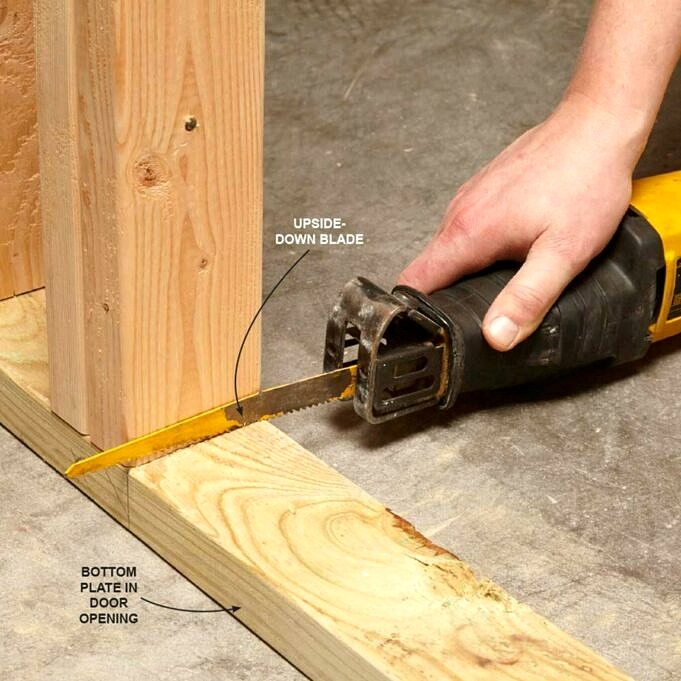A reciprocating saw is a powerful tool that can be used for a variety of applications, such as cutting straight lines. It is essential to learn how to properly use your reciprocating saw to get the best out of it.
This blog post will cover the best methods for cutting straight lines using a reciprocating saw. We will also provide some helpful tips and tricks that will make the process easier and more efficient. So, if you are interested in learning more about using a reciprocating saw, then keep reading!
How To Cut A Straight Line With A Reciprocating Saw Step By Step:
1. Get Yourself A Reciprocating Saw
A reciprocating saw is necessary to cut straight lines. You can use either an electric or pneumatic reciprocating saw for your application. A reciprocating saw, which is a small tool with a thin blade and can be used to cut through different materials quickly and efficiently, is simple to use.
They can be used with a variety materials thanks to their interchangeable blades. They can also be used horizontally or vertically.
2. Measure And Mark The Line You Want To Cut
Before you start cutting, measure and mark the lines you wish to cut. In order to do this, carry out a couple of trials runs on some spare material in order to get a good idea of how deep your blade will go into the object or surface you are planning to cut.
Once you have an accurate measurement, use a pencil to mark your cutting line.
3. Reduce Your Material
If you are planning to cut curves or make detailed cuts, clamping down your material can be very helpful. This step can be skipped if you don’t plan to make intricate cuts.
4. Slowly And Steadily Start To Cut
Now that your material is clamped down securely, its time to start cutting. After your material is securely clamped down, you can start to move your saw slowly backwards and forwards along your marked line.
To get a clean cut, it is a good idea for the saw to be held at a 90 degree angle. If you are using an electric reciprocating saw, make sure not to use too much force, or else you might splinter or crack your surface.
5. Continue On Until You Get To The End
When you have reached one end of your cutline, continue cutting all the way around until you have taken off enough material for your application.
Once this is done, carefully remove your clamps and release your material from them before taking it away from the saw.
6. For A Clean Cut, Keep The Blade Parallel To Your Marked Line.
It can be difficult to see what you’re doing because of all the sawdust created during cutting. Make sure your blade is parallel to your line to ensure a straight cut.
Once youve finished cutting, turn off your saw before removing it from the material. Then, carefully remove any remaining debris with a brush or vacuum cleaner before proceeding with whatever application you had in mind for this project-youre ready to go!
7. Remember To Support The Cut Line While You Are Cutting
You should not let any material get unsupported when you’re sawing it. Otherwise, you could end up with a discoloration or scratch on your cutline.
Make sure that whatever material you have clamped down is firmly held in place by your clamps before you start cutting.
8. Get Rid Of All The Junk
Now that most of your material has been removed, all thats left for you to do is clean up the edges. You can smoothen any burrs and rough spots with a file or sandpaper.
FAQs:
Do you have any special blades that can be used to cut straight lines?
Yes, there are. A reciprocating saw blade with reinforced teeth is best if you are planning to make many cuts at once, such as when making doorframes or window frames.
How should I hold the reciprocating saw while cutting?
Your reciprocating saw handle should always be in the same place. While you are cutting, hold the handle in one hand.
Never let go of the handle or rest the saw on the material while you are operating it.
How do you adjust the blade on a reciprocating saw so that you can cut straight lines?
To adjust the blade on your saw so that you can cut straight lines, first release it from its current position by pushing the locking lever upwards with one hand.
Then, use the wheel at the base of the armature to apply tension to it and push it back in place. While you are doing this, make sure that both ends of the blade remain in place, and that they are both resting tightly against the armature.
How long should a single cut take?
A standard reciprocating saw, which is a saw that cuts with no special blades, should take between 20 and 30 seconds to cut an average length of material. If the material you are cutting is hard and takes a lot of effort, then its best to pause halfway through and let the motor rest for a few seconds.
How can you ensure that the cut is straight?
Make sure that both blade ends are in direct contact with the material or surface while you cut. This will ensure that your cut is straight. As your cut progresses, keep checking on it until youve reached your desired length.
Conclusion:
This post will show you how to use a reciprocating saw to cut straight lines. You should be able make precise cuts with this power tool with the right technique and practice. What projects will you use your new skills on?



